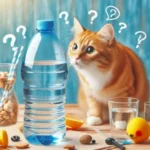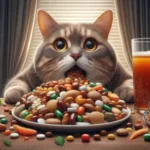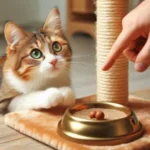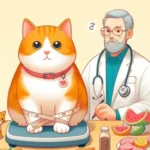As devoted cat owners, we all want to ensure that our furry companions enjoy the best of everything—especially when it comes to their diet.
While commercial cat food is formulated to meet their nutritional needs, many of us find ourselves curious about sharing the occasional human treat with our feline friends. However, not all human foods are safe for cats, and some can even be harmful. In this comprehensive guide, we’ll delve into the world of cat-friendly human foods, providing you with valuable insights on what’s safe to share and how to introduce these foods into your cat’s diet. From tasty fruits and vegetables to proteins that will make their whiskers twitch with delight, we’ll explore a variety of options that can enhance their meals and keep them healthy. Get ready to discover how you can safely treat your beloved pet and strengthen the bond you share over mealtime!
1. Introduction: Understanding Your Cat’s Dietary Needs

Cats, those enigmatic little creatures, have captivated our hearts and homes for centuries. As loving pet owners, we strive to provide them with the best care possible, which begins with understanding their unique dietary needs. Unlike dogs, cats are obligate carnivores, meaning their bodies are designed to thrive on a diet primarily composed of animal protein. This distinction is crucial when considering what human foods can be safely introduced into their diet.
Your feline friend requires a carefully balanced intake of specific nutrients to maintain their health and vitality. Essential amino acids, such as taurine, are indispensable for their heart health and vision. Additionally, arachidonic acid and vitamin A are vital fatty acids that cats cannot synthesize on their own. Therefore, the right mix of proteins, fats, and carbohydrates plays an integral role in their well-being.
While commercial cat food is formulated to meet these dietary requirements, the idea of sharing safe human foods can open up a world of culinary delight for your cat. However, this must be approached with caution and knowledge. Not all human foods are appropriate for feline consumption, and some can even be toxic. Understanding what constitutes a safe snack or meal supplement is essential for keeping your cat happy and healthy.
In this guide, we will explore various human foods that are not only safe but can also provide beneficial nutrients for your cat. From tasty treats to wholesome additions to their meals, we’ll delve into the options that can enhance your cat’s diet while satisfying their curious palate. Let’s embark on this journey of feline nutrition and discover how to feed our furry friends in a way that aligns with their natural dietary needs.
2. The Importance of a Balanced Diet for Cats
When it comes to feline nutrition, the significance of a balanced diet cannot be overstated. Just like humans, cats require a variety of nutrients to thrive, and their dietary needs are quite specific. As obligate carnivores, cats rely heavily on animal-based proteins and certain essential nutrients that can only be obtained from meat. This means that their diet should primarily consist of high-quality protein sources, complemented by fats, vitamins, and minerals.
A balanced diet helps maintain your cat’s overall health, supports their immune system, and promotes a shiny, healthy coat. Without the right balance, your furry friend may experience a range of health issues, from obesity and diabetes to dental problems and digestive disorders. For instance, too many carbohydrates from human foods can lead to weight gain, while deficiencies in essential fatty acids may result in skin issues or a dull coat.
Including safe human foods can be a wonderful addition to your cat’s diet, but moderation is key. Foods like cooked chicken, fish, and certain vegetables can provide extra nutrients and variety. However, it’s crucial to ensure these foods are introduced thoughtfully and don’t replace their primary cat food, which is formulated to meet all their nutritional needs. Consult your veterinarian before making any significant changes to your cat’s diet, as they can offer tailored advice that considers your pet’s age, weight, and health status.
Ultimately, a balanced diet is the cornerstone of a long, happy life for your feline companion. By understanding their dietary requirements and incorporating safe human foods wisely, you can contribute to their overall well-being and keep their playful spirit alive for many years to come.
3. Common Human Foods That Are Safe for Cats

When it comes to treating your feline friend, it’s essential to know which human foods are safe and beneficial for them. While cats are obligate carnivores primarily thriving on meat, certain human foods can offer them additional nutrients and variety in their diet. Here’s a list of common human foods you can safely share with your cat, ensuring they enjoy a little culinary adventure while remaining healthy.
**1. Cooked Chicken:** A classic favorite among cats, cooked chicken is not only tasty but also packed with protein. Ensure it’s boneless and skinless, and never serve it raw, as this can pose health risks.
**2. Fish:** Cats often love fish, and while it can be a delightful treat, moderation is key. Opt for cooked salmon or tuna, avoiding those canned in oil or with added salt. Fish should be an occasional treat rather than a staple, as it can lead to nutritional imbalances if fed too frequently.
**3. Pumpkin:** This superfood is not only safe but can also aid in digestion for your cat. Plain, canned pumpkin (not the spiced pie filling) is perfect for adding a little fiber to their diet. Just a spoonful can help regulate your cat’s digestive system.
**4. Carrots:** Cats may not be as enthusiastic about vegetables as dogs, but small amounts of cooked carrots can provide vitamins and minerals. Make sure they are soft and cut into small, manageable pieces to prevent choking.
**5. Green Beans:** These crunchy veggies are low in calories and can be a great source of fiber. Many cats enjoy the texture and taste of cooked green beans, making them a perfect snack.
**6. Eggs:** Cooked eggs are a protein powerhouse! Scrambled or boiled, eggs can be a nutritious addition to your cat’s diet. However, ensure they are fully cooked, as raw eggs can lead to the risk of bacterial infections.
**7. Plain Yogurt:** Many cats can handle a small amount of plain yogurt, which can be a fun treat. The probiotics in yogurt can also aid in digestion. However, be cautious with lactose-intolerant cats, as dairy can upset their stomachs.
Before introducing any new food into your cat’s diet, it’s always best to check with your veterinarian, especially if your cat has pre-existing health conditions. With these safe options, you can treat your feline companion to a varied and enjoyable dining experience, all while keeping their health in check.
4. Fruits Cats Can Enjoy: A List of Safe Options
When it comes to treating your feline friend to a little something special, fruits can offer a delightful and healthy snack option, provided you choose wisely. While cats are obligate carnivores, certain fruits can add a refreshing twist to their diet and even provide beneficial vitamins and hydration. However, not all fruits are safe for your kitty, so it’s essential to stick to those that are known to be cat-friendly. Here’s a list of safe fruits that your cat can enjoy:
1. **Blueberries**: Packed with antioxidants, blueberries are a crunchy treat that many cats find irresistible. They can be served fresh or frozen for a tasty summer snack.
2. **Watermelon**: Cats can enjoy small pieces of watermelon, which is hydrating and low in calories. Just be sure to remove the seeds and rind before serving, as they can pose a choking hazard.
3. **Cantaloupe**: This sweet melon is often a favorite among cats. The juicy flesh is safe for them to nibble on, and the aroma can be enticing, making it a popular choice for a snack.
4. **Strawberries**: Rich in vitamin C and fiber, strawberries can be a refreshing treat. Cut them into small, manageable pieces to prevent any choking hazards.
5. **Bananas**: While cats may not be the biggest fans of bananas, some enjoy the soft texture and sweet flavor. Just remember to offer them in moderation, as they are higher in sugar.
6. **Pineapple**: Fresh pineapple can be offered in small amounts. It’s a tropical delight that provides vitamin C, but make sure to remove the tough skin and core.
7. **Apple**: Cats can have small slices of fresh apple, but it’s crucial to remove the seeds and core, as they contain cyanide, which is toxic in large amounts.
8. **Peach**: Fresh peach flesh is safe for cats; however, avoid giving them the pit, as it can be a choking hazard and contains harmful substances.
Remember, moderation is key when introducing any new food into your cat’s diet. Always observe your feline for any adverse reactions or digestive upset after trying a new fruit. By providing these safe fruit options, you can treat your cat to something special while ensuring they remain healthy and happy.
5. Vegetables That Are Good for Cats

When it comes to incorporating vegetables into your feline friend’s diet, it’s important to choose wisely. While cats are obligate carnivores and primarily thrive on meat, certain vegetables can provide beneficial nutrients and variety to their meals. Here’s a look at some cat-friendly vegetables that can safely enhance their diet.
**Carrots** are a popular choice and can be served both raw and cooked. They’re packed with beta-carotene, which supports healthy vision and immune function. If you introduce carrots to your cat, try grating them or cooking them until soft, making them easier to chew and digest.
**Green beans** are another excellent option. They are low in calories and high in fiber, which can help with weight management if your cat tends to overindulge. Cats often enjoy the crunch of green beans, so you can offer them raw or lightly steamed.
**Peas** are not only colorful but also nutritious. They are rich in vitamins A, C, and K, as well as several B vitamins. Frozen peas are particularly handy—simply thaw them and serve. Just be sure to mash them slightly for easier consumption.
**Pumpkin** is a fantastic addition, especially for cats that may experience digestive issues. It’s high in fiber and can aid in regulating their digestive tract. Plain canned pumpkin (not the spiced pie filling) can be added to meals in small amounts.
**Spinach** can also be offered in moderation. Rich in vitamins and minerals, spinach contains calcium, iron, and antioxidants. However, if your cat has a history of urinary tract issues, consult your veterinarian, as spinach can contribute to the formation of calcium oxalate crystals.
When introducing any new food, start with small amounts to ensure your cat tolerates it well. Always avoid seasoning and stick with plain, cooked vegetables for the best results. By carefully selecting and preparing these vegetables, you can provide a nutritious boost to your cat’s diet while keeping mealtime interesting and enjoyable.
6. Meats and Proteins: What’s Safe and What to Avoid
When it comes to feeding our feline friends, understanding their dietary needs is crucial, especially when it involves introducing human foods into their meals. Cats are obligate carnivores, which means they thrive on a diet primarily composed of meat. However, not all proteins are created equal, and knowing which meats are safe for your cat—and which ones to avoid—can ensure their health and happiness.
### Safe Meats for Your Cat
1. **Cooked Chicken**: One of the most popular and safest options, cooked chicken is lean and packed with protein. Always ensure that it’s served plain, without any seasoning, sauces, or bones, as these can pose health risks.
2. **Turkey**: Just like chicken, turkey is a great source of protein. Offering small bits of cooked turkey, especially during the holidays, can be a delightful treat for your furry companion. Again, avoid any spices or gravy.
3. **Fish**: Many cats adore fish, and while occasional servings of cooked salmon or tuna can be a tasty addition to their diet, moderation is key. Fish should be cooked thoroughly and served without bones or skin. Avoid feeding raw fish, as it can harbor harmful bacteria.
4. **Beef**: Lean cuts of beef are also safe for cats, provided they are well-cooked and free from any seasoning. Ground beef can be a good option as well, but always opt for lean varieties to avoid excessive fat.
### Proteins to Avoid
1. **Raw Meat**: While some pet owners opt for raw diets, it’s essential to be cautious. Raw meat can carry bacteria like Salmonella or E. coli, which could be harmful to both cats and humans. If you choose to go the raw route, consult with a veterinarian to ensure safety.
2. **Processed Meats**: Deli meats, sausages, and hot dogs are often laden with salt, preservatives, and spices, making them unhealthy for your cat. High sodium content can lead to dehydration and other health issues.
3. **Bones**: While it’s a common misconception that bones are safe for cats, they can splinter and cause serious internal injuries. It’s best to avoid giving your cat any kind of bones, whether cooked or raw.
4. **Fatty Cuts**: While cats do need some fat in their diet, overly fatty meats can lead to obesity and pancreatitis. Always choose lean cuts and trim any excess fat before serving.
Incorporating safe meats and proteins into your cat’s diet can enhance their nutrition and provide them with the flavors they love. Just remember to introduce new foods gradually and in moderation, and consult your veterinarian if you have any concerns about your cat’s diet. By being informed and cautious, you can create a delicious and safe culinary experience for your feline companion!
7. Dairy: Myths vs. Reality for Cats

The age-old belief that cats love milk is one that has been perpetuated by cartoons, childhood stories, and our own experiences with kittens eagerly lapping up a bowl of the white liquid. However, the reality is a bit more nuanced. While many cats are drawn to dairy products, the truth about dairy and felines is steeped in both myth and misunderstanding.
Most adult cats are lactose intolerant, meaning their bodies lack the necessary enzyme, lactase, to properly digest lactose—the sugar found in milk. When these furry friends consume dairy, the result can be uncomfortable, leading to digestive upset, gas, and diarrhea. This contrasts sharply with the popular image of a cat enjoying a creamy bowl of milk, which can be misleading and detrimental to their health.
However, not all dairy is off-limits. Some cats may tolerate small amounts of certain dairy products, like cheese or yogurt, in moderation. These options often contain less lactose than milk. Additionally, there are specially formulated “cat milk” products available in pet stores, designed to be lactose-free while still satisfying your kitty’s craving for a creamy treat.
As a responsible cat owner, it’s essential to know your pet’s individual tolerance. If you want to treat your cat with dairy, start with a tiny amount and observe how they react. If they experience any adverse effects, it’s best to steer clear of dairy altogether.
In summary, while cats may seem to enjoy the taste of dairy, it’s essential to separate myth from reality. Educating yourself about your cat’s dietary needs and tolerances will help ensure their well-being, allowing you to provide safe treats that keep them happy and healthy.
8. Grains and Carbs: Can Cats Eat Them?
When it comes to feline diets, the inclusion of grains and carbohydrates can often spark debate among pet owners and veterinarians alike. Cats are obligate carnivores, which means their natural diet primarily consists of meat. However, this doesn’t mean that grains and carbs are entirely off the table. In fact, certain whole grains can provide a source of energy and fiber, which may be beneficial for your cat in moderation.
Common grains such as brown rice, oatmeal, and quinoa can be safely fed to your feline friend. They are less likely to cause digestive issues compared to processed grains or those containing gluten. When introducing grains, it’s essential to do so gradually and in small amounts to monitor your cat’s reaction. Some cats may have sensitivities or allergies, and any sudden dietary changes could lead to gastrointestinal upset.
Carbohydrates can also play a role in your cat’s diet, primarily as a source of energy. That said, not all carbs are created equal. Avoid feeding your cat sugary foods or processed snacks, as these can lead to obesity and health issues. Instead, consider offering small amounts of cooked sweet potatoes or peas, which are not only safe but also packed with nutrients.
As always, consult with your veterinarian before making significant changes to your cat’s diet. They can guide you on the appropriate types and quantities of grains and carbs that may be suitable for your furry companion. Remember, while a little grain here and there won’t harm your cat, their primary nutrition should always come from high-quality sources of protein. Balancing their diet carefully will ensure they remain happy, healthy, and satisfied!
9. Treats and Snacks: Healthy Human Foods for Cats
When it comes to treating your feline friend, it’s essential to choose snacks that not only delight their taste buds but also contribute to their overall health. While cats are obligate carnivores, their curiosity extends beyond their kibble, and many human foods can make excellent occasional treats. Here are some safe and healthy options to consider:
**Cooked Lean Meats:** Cats adore meat, and well-cooked chicken, turkey, or even lean beef can be a delightful snack. Ensure there are no bones or seasoning, as these can be harmful. Simply shred or cut the meat into small, manageable pieces, and watch your cat perk up with excitement!
**Fish:** Most cats have a natural affinity for fish, and options like cooked salmon or tuna can be a special treat. Again, ensure it’s cooked without any added oils or spices. Just a small portion will suffice, as too much fish can lead to nutritional imbalances.
**Fruits and Vegetables:** While cats may not be as enthusiastic about fruits and veggies, some can be safe and beneficial. Small pieces of cooked carrots, peas, or even a few blueberries can offer a crunchy, low-calorie snack. However, always introduce new foods slowly and observe for any adverse reactions.
**Eggs:** Cooked eggs are another protein-packed option that many cats enjoy. Scrambled or hard-boiled eggs, served plain, can be a great way to add variety to their diet. Just be sure to cook them thoroughly to eliminate any potential risks associated with raw eggs.
**Pumpkin:** Canned pumpkin (not the spiced pie filling) is a fantastic treat that can aid in digestion and is high in fiber. A small spoonful mixed into their regular food can help with occasional tummy troubles while also being a tasty addition.
Remember, while these treats can be a healthy supplement to your cat’s diet, moderation is key. Any new food should be introduced gradually to prevent digestive upset, and it’s always best to consult with your veterinarian before making significant changes to your cat’s diet. With these tasty and nutritious options, you can keep your feline companion happy, healthy, and coming back for more!
10. Foods to Avoid: Toxic and Harmful Foods for Cats
When it comes to feeding your feline friend, knowledge is power, especially when it involves understanding which human foods can pose serious health risks. While many foods are safe and even beneficial for cats, there are several that can be downright dangerous. To ensure your cat remains healthy and happy, it’s crucial to avoid the following toxic and harmful foods.
**Chocolate** is one of the most well-known dangers for pets. It contains theobromine, a compound that can cause a range of symptoms from vomiting and diarrhea to seizures and even death. Just a small amount can be harmful, so it’s best to keep all chocolate products securely out of reach.
**Onions and garlic**, whether raw, cooked, or powdered, can lead to gastrointestinal upset and damage to red blood cells, resulting in anemia. Even small quantities can be toxic, making it essential to avoid these common kitchen staples.
**Grapes and raisins** might seem like a healthy snack, but they can lead to acute kidney failure in cats, even in small amounts. The exact substance causing this reaction is still unknown, but the risk is significant enough that these fruits should never be offered.
**Alcohol**, even in small doses, can be extremely toxic. It can result in vomiting, diarrhea, difficulty breathing, and potentially coma or death. Always ensure that alcoholic beverages are kept well away from your curious kitty.
**Caffeine**, found in coffee, tea, and some sodas, can also be dangerous. It can cause restlessness, rapid breathing, heart palpitations, and muscle tremors.
Lastly, **bones and fat trimmings** from meat can pose choking hazards, and cooked bones can splinter and cause blockages or lacerations in your cat’s digestive tract. It’s best to avoid giving any bones, as well as the fatty scraps from your meals, to keep your feline companion safe.
By being aware of these toxic foods, you can protect your cat from harmful consequences and ensure their diet remains safe and nutritious. Always consult your veterinarian if you’re unsure about a specific food, and when in doubt, it’s best to stick with a balanced diet formulated specifically for felines. Your furry friend will thank you for it!
11. Portion Control: How Much Human Food Is Too Much?
When it comes to feeding your feline friends human food, moderation is key. While it’s tempting to share your meals with your cat, it’s crucial to understand that not all human foods are created equal, and portion control is essential to keep your kitty healthy and happy.
Cats are obligate carnivores, which means their bodies are designed to thrive on a diet primarily composed of meat. However, incorporating human foods can provide variety and enrichment to their diets. The challenge lies in ensuring that these additions don’t lead to overindulgence or nutritional imbalances.
As a general rule of thumb, human food should only make up about 10% of your cat’s daily caloric intake. For example, if your cat requires around 200 calories per day, only about 20 of those calories should come from human food. This is where knowing portion sizes and calorie counts becomes vital. Foods like cooked chicken, turkey, and certain vegetables can be excellent treats, but they should be given in small, controlled amounts.
When introducing new foods, it’s best to start with tiny portions—think of it as sampling rather than a full meal. Observe how your cat reacts, both in terms of taste and digestion. If they seem to enjoy the new flavor and show no adverse reactions, you can gradually increase the serving size, but always keep it within that crucial 10% limit.
Furthermore, be mindful of the frequency of these treats. Instead of offering human food every day, consider designating a special “treat day” once a week. This not only helps maintain balance in their diet but also makes these moments feel like a special occasion for both you and your furry companion.
Lastly, consulting your veterinarian about the best human foods for your cat and their specific nutritional needs can provide tailored guidance. With the right approach to portion control, you can safely enhance your cat’s diet with human foods while ensuring they remain healthy and thriving.
12. Transitioning Your Cat to Human Foods Safely
Transitioning your cat to human foods can be a rewarding experience, but it’s essential to approach this change thoughtfully and safely. Cats are creatures of habit, and a sudden shift in diet can lead to digestive upset or refusal to eat. To ensure a smooth transition, start by introducing human foods gradually, mixing small amounts with their regular cat food. This familiarizes your feline friend with new flavors and textures without overwhelming their system.
Begin with easily digestible options like cooked chicken, turkey, or small pieces of fish, ensuring they are free of seasoning, salt, and any potential toxins like onions or garlic. Offer these new additions in moderation, as treats or mixed into their meals, observing their reactions closely. If your cat shows interest and handles the new food well, you can slowly increase the quantity while decreasing their original cat food over the course of several days.
Monitor their digestion during this transition—watch for any signs of upset stomach, diarrhea, or unusual behavior. If any issues arise, revert to their original diet and consult your veterinarian before proceeding further. Remember, every cat is different; what one may enjoy, another might turn their nose up at. Patience is key, as is celebrating each small victory. With time and care, you can expand your cat’s palate while ensuring they remain healthy and happy.
13. Signs of Food Allergies in Cats
Recognizing signs of food allergies in cats is crucial for their health and well-being. While cats might be known for their finicky eating habits, a sudden change in their behavior can indicate an underlying issue. Allergies can manifest in various ways, and being vigilant about your cat’s health is essential for timely intervention.
One of the most common signs of food allergies is skin irritation. If your cat develops excessive itching, redness, or rashes, it could be a reaction to a specific ingredient in their diet. Look for localized areas of fur loss or scabs, which may indicate that your cat is scratching or biting at the affected areas due to discomfort.
Gastrointestinal issues are another red flag. If you notice frequent vomiting, diarrhea, or changes in your cat’s stool consistency, it may suggest that their body is reacting negatively to certain foods. Pay attention to any patterns—such as symptoms appearing consistently after eating specific meals—as this can help you identify potential allergens.
Behavioral changes can also be a telltale sign of food allergies. A normally playful and energetic cat might become lethargic or withdrawn when experiencing discomfort from an allergic reaction. Changes in appetite, such as an aversion to food or sudden overeating, may also occur.
If you suspect that your cat is suffering from food allergies, it’s vital to consult your veterinarian. They can assist you in identifying the culprit through elimination diets and allergy testing, ensuring that your feline friend receives a balanced diet free from allergens. By being proactive and attentive to these signs, you can help your cat lead a healthier, happier life free from the discomfort of food allergies.
14. Consulting Your Veterinarian: When to Seek Professional Advice
When it comes to the health and well-being of your feline friend, consulting your veterinarian is not just a precaution—it’s a necessity. While many human foods are safe for cats, there are nuances in individual health conditions, dietary needs, and potential allergies that only a professional can adequately address.
If you’re considering adding new human foods to your cat’s diet, or if you notice any unusual behavior or symptoms after feeding them something different, it’s crucial to seek professional advice. Your veterinarian can provide insights based on your cat’s specific health history, age, and lifestyle, ensuring that any dietary changes are safe and beneficial.
Additionally, there are instances when a seemingly harmless food could pose a risk. For example, while cooked chicken is often a hit with cats, certain seasonings or additives can be harmful. A vet can guide you on what to avoid, helping you make informed decisions that prioritize your pet’s safety.
Regular check-ups with your veterinarian are also an opportunity to discuss your cat’s nutrition and any concerns you may have. They can recommend the best human foods to incorporate into your cat’s diet and suggest appropriate portion sizes.
Remember, just because a food is generally safe doesn’t mean it is right for your specific cat. Always err on the side of caution and consult your veterinarian when in doubt. Their expertise will ensure that your efforts to diversify your cat’s diet enhance their health and happiness, rather than compromise it.
15. Conclusion: Making Informed Choices for Your Cat’s Diet
In conclusion, navigating the world of feline nutrition can feel overwhelming, but making informed choices about your cat’s diet is essential for their health and happiness. By understanding which human foods are safe and beneficial for your furry friend, you can enhance their meals and enrich their lives. It’s important to remember that cats are obligate carnivores, meaning their diet should primarily consist of animal-based proteins. However, incorporating small amounts of safe fruits, vegetables, and cooked grains can provide variety and additional nutrients.
When introducing new foods, always proceed with caution. Start with small portions and monitor your cat for any adverse reactions, as each feline is unique and may have different sensitivities. Keep in mind that not all human foods are created equal; some are outright harmful to cats, so it’s crucial to do your research and consult with your veterinarian when in doubt.
Ultimately, a balanced diet that caters to your cat’s specific needs will help maintain their energy levels, support their immune system, and promote overall well-being. By thoughtfully selecting safe and nutritious human foods, you not only treat your cat to delicious additions to their diet but also strengthen the bond you share through an enjoyable and healthy mealtime experience. With the right knowledge and care, you can ensure that your beloved feline thrives, both in body and spirit.
In conclusion, we hope this guide has illuminated the world of safe human foods for your feline friend, allowing you to enrich their diet while keeping their health in mind. Understanding what foods are safe not only strengthens the bond between you and your cat but also ensures their well-being. As you venture into the kitchen to share a little something special with your furry companion, remember to introduce new foods gradually and observe their reactions. With a little creativity and caution, mealtime can become an exciting experience for both of you. Thank you for joining us on this culinary journey, and may your cat enjoy every delicious moment!






